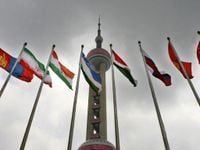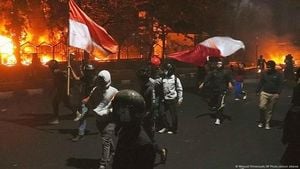India is walking a diplomatic tightrope in 2025, balancing between powerful global forces and shifting alliances as it prepares to take center stage at the Shanghai Cooperation Organisation (SCO) summit in Tianjin, China, from August 31 to September 1. The summit, set against the backdrop of US-imposed tariffs, deepening energy ties with Russia, and a tentative thaw with China, is drawing more than 20 foreign leaders and the heads of 10 international organizations, making it one of the most watched geopolitical gatherings of the year.
Prime Minister Narendra Modi’s visit to China—his first since 2018—marks a pivotal moment in India’s foreign policy. As reported by The Federal, the US, under President Donald Trump, has hit Indian exports with tariffs reaching as high as 50 percent, targeting crucial sectors such as textiles, jewellery, and leather. This move has delivered a billion-dollar blow to manufacturing hubs like Tirupur, Surat, and Ludhiana, threatening jobs and economic growth. Washington’s accusation that India is profiteering from discounted Russian oil—despite having encouraged these purchases in the past to stabilize global prices—has only added to the diplomatic strain.
Yet, as the US tightens the screws, India’s relationship with Russia has only grown stronger. According to The Federal, bilateral trade between the two countries soared to a record $68.7 billion in the previous year, driven not just by oil, but also by pharmaceuticals and engineering products. Ongoing discussions may soon see Indian workers heading to Russia for IT, construction, and skilled labor roles, with Moscow promising steady supplies despite mounting US pressure. This partnership is a lifeline for India’s energy security and a buffer against Western sanctions.
China, meanwhile, is seizing the opportunity to strengthen its hand. Beijing’s envoy to New Delhi, Xu Feihong, publicly condemned Washington’s tariff actions, pledging to “firmly stand with India to uphold the multilateral trading system with the WTO at its core.” Since Modi’s meeting with Chinese President Xi Jinping in Kazan last year, there has been a tentative improvement in India-China ties, even as border tensions persist. Dialogue channels have reopened, and both sides appear eager to find common ground, at least economically.
Japan, too, is emerging as a crucial partner in India’s balancing act. Modi has positioned India as a destination for Japanese capital, infrastructure, and technology, aiming to reduce China’s dominance in Asia’s supply chains. For Japan, investing in India represents a strategic bet on the region’s future, while for India, it’s a chance to diversify economic dependencies and strengthen its position in the Indo-Pacific.
As The Federal notes, India’s strategy now rests on four pillars: resisting US tariffs, deepening ties with Russia, managing a fragile relationship with China, and building trust with Japan and other Indo-Pacific partners. Senior journalist Sridhar Krishnaswamy described the situation as “tight rope walking,” emphasizing that “India and Japan are very important, especially in the context of the Quad. If the US pulls away, can the other three step in? These things cannot happen overnight.”
The SCO summit in Tianjin is not just about India. According to Al Jazeera, the event is set to be one of China’s most significant diplomatic showcases this year, with leaders from Russia, Iran, Pakistan, Belarus, Kazakhstan, Uzbekistan, Kyrgyzstan, Tajikistan, and others in attendance. High-profile figures such as Turkey’s President Recep Tayyip Erdogan and United Nations Secretary-General Antonio Guterres will join the gathering, underscoring its global significance.
The SCO’s origins date back to 1996 as the “Shanghai Five,” a bloc formed to resolve post-Cold War border disputes. Over time, it has expanded to include India and Pakistan (2017), Iran (2023), and Belarus (2024), now representing 43 percent of the world’s population and nearly a quarter of the global economy. The group’s mandate has evolved from regional security to encompass trade and the interests of the Global South, though its identity remains a work in progress.
Analysts cited by Al Jazeera point out that the SCO’s guiding principle of “indivisible security”—the idea that security for one member cannot come at the expense of another—stands in stark contrast to NATO’s bloc-based approach. This year’s summit takes place amid ongoing crises, including Russia’s war in Ukraine and Israel’s military operations in Gaza, adding layers of complexity to the discussions.
Despite its growing clout, the SCO often struggles to reach consensus on contentious issues. Russia, for example, has managed to align most members with its stance on Ukraine, but India has charted a more balanced course, seeking both peace and stronger ties with Ukraine while importing record amounts of Russian oil. On the Middle East, India’s refusal to join a joint SCO statement condemning Israel’s actions in Iran highlights the persistent friction among members, particularly given New Delhi’s strong ties with Tel Aviv.
Friction also persists between India and Pakistan, especially over cross-border terrorism. In July, after a deadly attack in Indian-administered Kashmir, India demanded the SCO condemn the violence and blamed Islamabad—an accusation Pakistan denied. When the group, which operates by consensus, declined to do so, India withheld its signature from a joint statement after a defense ministers’ meeting. These divisions underscore the challenges of forging a unified front in such a diverse organization.
The symbolism of the SCO summit is not lost on observers. As Alejandro Reyes of the University of Hong Kong told Al Jazeera, “This is a time when the US is burning bridges with almost every country. So in President Xi’s mind, it is a good time for China to position itself as a world power by showcasing it has productive relations with many countries.” The summit, followed by a major military parade in Beijing, is a carefully orchestrated display of China’s diplomatic reach and its ambition to unite the Global South as a counterweight to the West.
The US, for its part, is watching closely. Trump’s administration has been openly critical of organizations like the SCO and BRICS, threatening tariffs and labeling them “anti-American.” Yet, as Manoj Kewalramani of the Takshashila Institution in Bangalore notes, the India-US relationship remains fundamentally strong, with both countries maintaining close ties on multiple fronts. The real test will be how India navigates its interactions with China at the SCO summit and the upcoming Quad Summit, which it is set to host later this year.
For India, the stakes could hardly be higher. Export markets are under threat, energy security is uncertain, and regional rivalries are intensifying. The challenge is not just to withstand these shocks, but to emerge as a steady, credible voice in an increasingly fractured world. Whether New Delhi can master this high-wire act remains the billion-dollar question.






